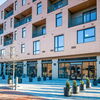Processing Your Payment
Please do not leave this page until complete. This can take a few moments.
Building a brand | The new owners of Ledgewood Inc. increase its visibility in order to increase revenues
Outside the construction site, it's hard to miss the name Ledgewood Inc. It appears on signs affixed to the black mesh ringing the construction site and on the doors of spotless blue pickup trucks entering and exiting through a gap in the Fore Street barriers. In short, it's clear that Ledgewood is running the show.
In the 18 months since Peter Benard and Kevin French acquired South Portland-based construction firm Ledgewood Inc. from founder Bill Barthelman, the most no-ticeable change is the company's increased visibility. Ledgewood signs are prominently displayed on every job site, and press releases and advertisements tout the firm's newest projects or the most recent addition to the company's staff. What's more, Ledgewood has boosted its share of Maine's high-profile commercial projects, including large projects from Portland to Camden.
Despite the company's increased visibility, Benard and French, both 40 years old, aren't positioning Ledgewood to go head-to-head with the 800-pound gorillas of Maine's commercial construction industry such as Cianbro and Granger Northern. Instead, they're drawing from their experiences working for big-name firms such as Cianbro and Vermont-based Pizzagalli Construction to usher in the new era at Ledgewood. The result is a firm that pairs big-business acumen with a small-company sensibility. "We don't want to be the biggest company out there because we'd end up losing a lot of contact with our clients and our personal involvement with each project would decrease," says French. "We want to make sure our clients are happy."
While French's sentiments may come across as heard-it-before business pabulum, both Benard and French are positively evangelical when it comes to Ledgewood, and their enthusiasm comes without a hint of irony or insincerity. In their world, clients are revered and employees are treated like family. It's school pride taken to the next level. Case in point: French just bought a chopper from American IronHorse Motorcycle Company and had it custom painted in Ledgewood blue with a diamond plate motif that screams construction.
But their enthusiasm is tempered by a very calculated, business-oriented approach to running the company. Benard and French want Ledgewood to run like a well-oiled machine, and they're constantly tinkering with the company's operations to maximize its resources. For example, they hired a full-time warehouse manager to make sure job-site workers have the tools they need, saving countless hours of downtime. Their efforts are starting to pay off: According to Benard and French, Ledgewood's profit margins land squarely in the industry average of two to four percent for companies its size. What's more, the company's revenues rose to $40 million in 2003, up more than 33% from the year before, and the pair expects revenues to hit $48 million this year and $50 million in 2005.
Market opportunities
In the winter of 2001, Peter Benard spent months trying to convince Kevin French ˆ a colleague in the South Portland office of Pizzagalli Construction Company ˆ that they should partner up and acquire a construction company. Though the timing was never right for French, the two agreed that their management styles would complement each other perfectly as business owners. "I'm the big-picture guy, and Peter's more detail-oriented," says French.
Benard's persistence paid off. In the late summer of 2002, the two decided to strike out on their own, and began identifying possible acquisition targets. Their criteria: an established company with strong personnel, solid infrastructure and a good reputation in the local building and construction community. More importantly, Benard and French also were looking for a firm that had room to grow. After narrowing the field down to a handful of companies, Benard and French settled on Ledgewood, finding the company's expertise in commercial construction ˆ particularly in the medical construction area ˆ well suited to the pair's past construction experience. "It was a perfect match," says French. "The company had a great reputation and we were very familiar with the type of work Ledgewood had been doing, but the management needed a jumpstart."
At the time, Ledgewood was comfortably coasting along, maintaining its solid reputation in the southern Maine commercial construction industry and pulling in dependable revenues. Barthelman had guided Ledgewood from a fledgling, three-employee company with $300,000 in revenues in 1978 to a firm with more than 40 employees and $30 million in annual revenues in 2002. But Barthelman, nearing retirement, was becoming more and more selective about the jobs Ledgewood took on.
While researching the company, Benard and French evaluated the types of projects available in the local marketplace, and saw that very few of the larger, $5 million to $10 million jobs were attached to Ledgewood's name. "There was an area of the market that wasn't being tapped and we figured it was a clear opportunity," recalls French.
Benard and French made an offer ˆ they wouldn't disclose the amount ˆ that Barthelman accepted. In addition, Barthelman agreed to stay on for a year to smooth the transition. When the pair took over Ledgewood in November 2002, they performed an intensive month-long internal audit to see how the company was being run. The result: The new owners found that the company's resources were underutilized by roughly 25%. One problem: The accounting offices were bogged down with redundant paperwork, a constant problem in the document-heavy construction industry.
The new owners' solution was to embrace technology, laying out roughly $20,000 for project management, accounting and estimating software by Beaverton, Ore.-based Timberline. Taking that one step further, Benard hired a software programmer to help him tweak the program to better fit the company's needs. The result has been a more streamlined office where project managers' reports are connected directly to the accounting and estimating departments. But most importantly, the software links outside sources such as subcontractors and architects with the company, helping to reduce the flow of paperwork on each project. "We've spent more than double the software's price just customizing it," says Benard. "It's been a major expense, but it's well worth the cost."
Uncomfortable with the status quo
Once Benard and French settled in to their roles as owners, they continued to look for ways to make better use of Ledgewood's resources. In addition to making software upgrades, they reexamined the roles of the company's employees and made some additions to the company's staff. One of the first new hires was marketing director Melissa Webster, a carefully planned move on the part of the new owners. "Every big company has someone doing marketing, and we wanted to boost Ledgewood's visibility," says French.
Scott Tompkins, deputy director at Associated Constructors of Maine in Augusta, praises Benard and French's use of marketing to raise the firm's profile. The bulk of Ledgewood's projects ˆ between 60% and 70% ˆ are negotiated jobs, which helps the company avoid seeking contracts as the low bidder. "Ledgewood's niche is negotiated work, and part of that is being very skillful marketers," says Tompkins. "They're marketing themselves in an industry that, quite frankly, doesn't like to blow its own horn. But there's a lot more competition in the marketplace these days and companies need to differentiate themselves. Ledgewood's doing a great job at that."
Ledgewood's marketing ˆ as well as its strong reputation in the industry ˆ helped land the job on the corner of Portland's Fore Street and Franklin Arterial. The project, a $9 million, 114,000-square-foot office building owned by Olympia Equity Investors, will house the offices of accounting firm Baker, Newman & Noyes. "We hadn't worked with Ledgewood before, but we've been very impressed by the culture of the company," says Jim Brady, a partner at Olympia, which also developed the adjacent Hilton Garden Inn. "They're young, aggressive and their follow-through is impressive."
Ledgewood gets the same high marks from clients who have worked with the firm for years. Mark McAuliffe, CEO of Portland-based Orthopaedic Associates, first dealt with Ledgewood in 1994. Before McAuliffe's tenure at Orthopaedic Associates, Ledgewood in 1989 had done extensive construction at Orthopaedic Associate's Sewall Street location, installing two operating rooms, a physical therapy center and 30 examination rooms. When McAuliffe arrived in 1994, he contacted Ledgewood to take care of some leaks in the roof. Bill Barthelman sent over a crew to repair the leaks at no charge.
Orthopaedic Associates used the company again in 1998 for a 2,000-square-foot expansion, and Ledgewood recently completed another 8,000-square-foot addition that included two new operating rooms and office space. "We were a little worried when Bill was leaving Ledgewood, but Kevin and Peter have been great to work with," says McAuliffe. "They've been quick to deal with any problems we've had, whether it's stopping construction because it's too loud or making sure the right subcontractor is on the job."
While it would seem that Ledgewood's star is rising, Benard and French are quick to note that they don't want the company to become too large. Revenues grew rapidly during the pair's first year owning Ledgewood, but Benard and French expect revenues to top out around $50 million in 2005, a level they'll spend time maintaining rather than trying to exceed. Reason: Benard and French wouldn't be able to keep up the personal involvement they want to have in each project with more than their average of 10 to 12 projects per year. But after the rapid growth that Ledgewood has experienced under its new command, Benard and French aren't about to rest on those accomplishments. "A lot of construction firms don't like change and are comfortable with the status quo," says French. "We like change. Change is good."









Comments